The layout of the binding of the indirect heating boiler + the rules for its installation and connection
To provide the house with the necessary amount of hot water, an additional device is used - an indirect heating boiler (BKN). Its use can be considered one of the most rational and economically viable.
We will try to find out which circuit of the indirect heating boiler strapping is the most effective and how to connect the equipment to avoid common mistakes.
The content of the article:
Choice of indirect heating boiler
Before buying and connecting a buffer battery tank (also called BKN), you should understand the design features of the most popular types. The fact is that there are many types of equipment, including combined models that work from heating systems and alternative energy sources at the same time.
We will look at traditional boilers with a coil that use hot water as a heater.
Design features and principle of operation
What does indirect heating mean? Devices with direct heating operate by connecting to electricity or a gas burner, the BKN has a different heat source. Water is heated by connecting to a hot water supply, that is, it turns out that the source is the coolant - hot water (or its substitute).
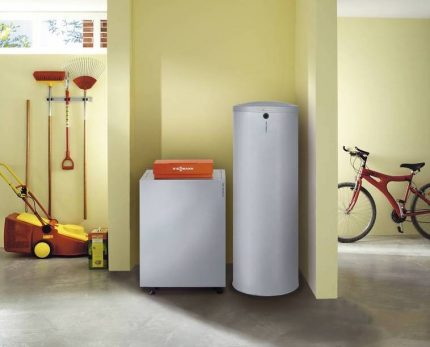
If we consider new models of well-known brands, we can see that gas boilers and KN boilers often have the same design.They are mounted next to or one below the other - so you can save on the area of accommodation.
The main element that performs the heating function is a steel or brass heat exchanger (coil) with a large surface area, which is located inside a metal tank covered with a protective layer of enamel. To prevent water cooling from happening too quickly, on the outside the case is surrounded by a layer of thermal insulation, and some models by a casing.
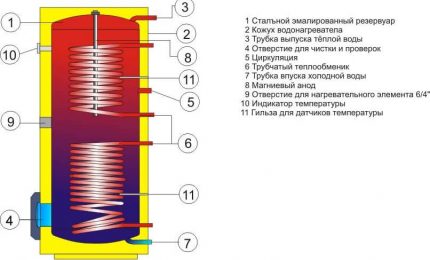
An important part that most heaters are now equipped with is the magnesium anode. A rod mounted in the upper part of the device protects metal parts from corrosion, as a result, the water heater lasts much longer.
High pressure barriers are safety valve and built-in thermostat. If the tank is not equipped with a safety group, it is installed separately, when arranging the strapping.
Often the water circulating in the heating system does not exceed 65-70 ° C. Many doubt its effectiveness when it acts as a heat source for heating in BKN. In fact, the indicated temperature is enough, because the speed and magnitude of the heat transfer largely depends on the area (rather large) of the contact of the coil with water.
How is the heating process going? Cold water intended for heating enters through a separate hole and fills the entire tank. Water, but already heated, also enters the heat exchanger from the boiler. The hot walls of the coil transfer heat to cold water, which at the outlet already has a temperature suitable for taking a shower or washing dishes.
Advantages of Controlled Equipment
Possibility of control - a characteristic that affects the assembly of the entire water heating system. There are two types of BKN: simple (cheaper) and with a built-in control function.
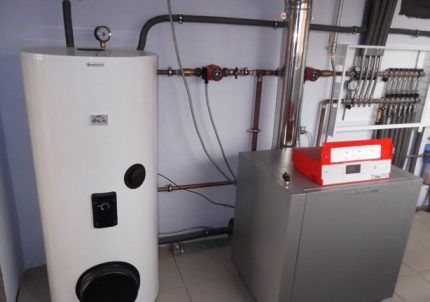
A distinctive feature of the controlled models is the additional equipment with a temperature sensor and the possibility of feeding / stopping water supply to the heat exchanger. Such equipment operates in automatic mode.
To start, you must connect:
- hot water inlet / outlet;
- cold water supply to the tank;
- collector for the distribution of heated fluid at the outlet.
After that, you can start the boiler - the water will begin to heat up.
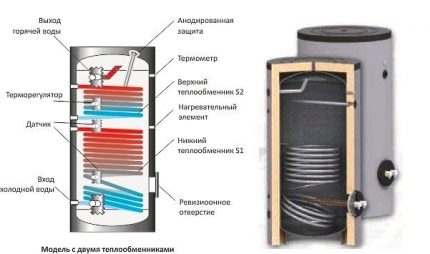
The process of connecting and tying an indirect heating boiler occurs in one of the ways (description below).
How can control affect water temperature? Almost nothing. The maximum value that the outlet temperature can reach does not exceed the parameters of the coolant in the DHW system. Most likely, it will be 1-2 ° C lower.
If more intensive heating is needed (this can happen if the boiler usually operates in low temperature mode), then it is better to choose a model with a built-in heating element.
It is advisable to buy such equipment together with solid fuel boilers (water remains hot even after the boiler cools down).
Varieties of devices with additional features
Tanks with a simple design are only part of the assortment on the market for water heating equipment. There are many boiler modelswhose functions are very useful for integration into the DHW system.
For example, one of the purposes of more expensive models is heat storage. If there may be a power outage or daily consumption rates are too high, the accumulation mode will be very useful. The structural features of such models are enhanced thermal insulation and an increased volume of the tank (300 l or more).
Another option that implements the fastest supply of hot water to the taps is a recirculating boiler. Unlike the conventional design, this one is equipped with three communication pipes with a hot water supply system. Hot water is supplied in two, cold in one. The water supply is carried out using a pump.
When using a model with recirculation, you can equip an additional useful circuit, for example, for mounting a heated towel rail.
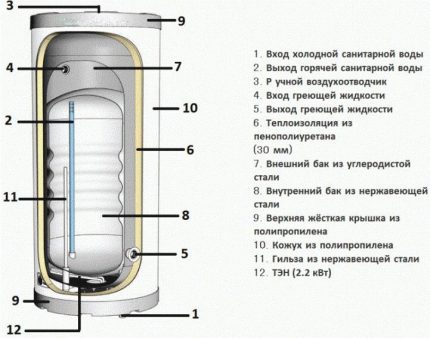
Water in such a tank heats up faster than in units with a heat exchanger, but its cost is higher.
Tank size and value
Cylindrical and cubic tanks differ in their size. Their volume is indicated in liters: there are small models for 80-100 liters, but there are also bulky ones that can hold up to 1400-1500 liters. The size is selected based on the family's need for hot water.
Dimensions are important during installation. For wall mounting, only light models are suitable - up to 200 liters, all the rest are floor-mounted. Both horizontal and vertical wall mounted devices have special mounts; floor-mounted devices are equipped with legs or a small stand.
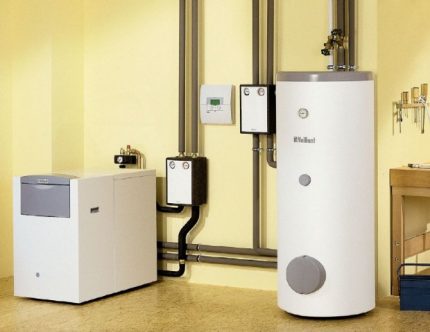
Rectangular units occupy a little less space than cylindrical ones, due to the tight fit to the pipes.
The nuances of the strapping device
It is easier to make wiring and piping if the KN boiler is installed together with the boiler, pumps and other equipment involved in the assembly of the DHW system. Embedding an additional device into an existing network is much more difficult.
In any case, for the normal operation of the devices you will have to follow a number of rules:
- choose the right installation location - as close to the boiler as possible;
- provide a flat surface for mounting the boiler;
- to protect against thermal expansion, install a membrane accumulator (at the outlet of heated water), the volume of which is at least 1/10 of the volume of the BKN;
- equip each circuit with a ball valve - for convenient and safe maintenance of devices (for example, a three-way valve, pump or the boiler itself);
- to prevent backflow on the water supply pipes, install check valves;
- improve water quality by tapping filters;
- correctly position the pump (or several pumps) - the motor axis should be in a horizontal position.
For safety reasons, do not attempt to attach heavy devices to plasterboard or thin wooden partitions. Suitable are concrete and brick walls. Brackets or other types of holders are fixed with brackets, anchors, dowels.

When installing, the nozzles are directed towards the boiler (even if they are masked in the rear or behind the false wall). Unreliable equipment, such as corrugated hoses that do not withstand the pressure and pressure of the water, must not be used.
For the normal operation of the indirect storage water heater, the following functional devices must be included in the piping:
Priority Connectivity
Before installing an indirect heating boiler in the DHW system, it is necessary to choose the principle of its connection: with or without priority. In the first case, when it becomes necessary to quickly obtain a large amount of hot water, the entire volume of the coolant is pumped through the BKN coil, as a result of which the water heats up much faster.
After the water temperature has reached the required level (measured with a thermostat), there is a way to redirect the flow to the radiators.
Connection without priority does not allow the passage of the entire volume of the coolant, and the boiler serves only part of the total flow. When equipped with such a scheme, the water heats up longer.
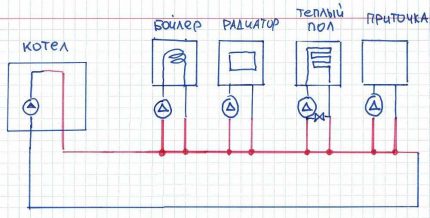
The priority scheme is more effective, since it makes it possible to quickly heat the required amount of water without compromising heating. If the heating devices are turned off for 30-50 minutes, the temperature in the rooms in such a short period of time is unlikely to decrease, but there will be enough heated water.
The only condition for priority circuit equipment is powerful boiler.
Schemes and rules for connecting BKN
The wiring diagram and installation features of the indirect heating boiler depend on the class of the device and home heating systems. It is necessary to choose the installation site correctly, focusing on the location of the boiler, the inset of the pumps and the existing wiring. Let's try to figure out what needs to be considered when installing heating equipment.
Option # 1 - piping with a three-way valve
This is one of the most popular schemes, since when it is used, the heating system and the BKN are connected in parallel, equipped with shutoff valves. The boiler must be installed near the boiler, insert a circulation pump into the feed, then a three-way valve.
This scheme is successfully applied if several heating devices are used, for example, two different boilers.
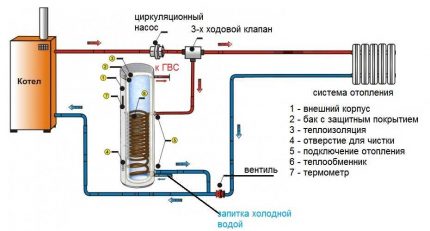
In fact, this is a priority system that provides quick heating of water in the boiler with the radiators completely turned off for a while. As soon as the temperature rises to the set value, it reacts again three-way valve and returns the coolant to its former channel - to the heating system. This binding method is useful for those who use the boiler in constant mode.
Option # 2 - circuit with two circulation pumps
If the boiler is rarely used (for example, seasonally or on weekends) or there is a need for water whose temperature is lower than in the heating system, a scheme with two water heating systems with forced circulation: schemes, implementation options, technical details of circulating pumps. The first is installed on the supply pipe, directly in front of the BKN, the second - on the heating circuit.
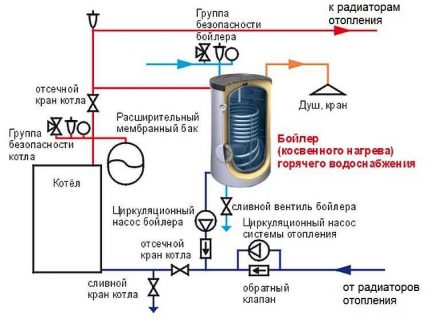
There is no three-way valve in this circuit; the harness is equipped with simple connecting tees.
Option # 3 - harness with hydraulic arrow
This connection is used for volumetric boilers (200 l and more) and branched heating systems with many additional circuits. An example is the heating system in a two-story house, where in addition to the multi-circuit radiator network, warm floor.
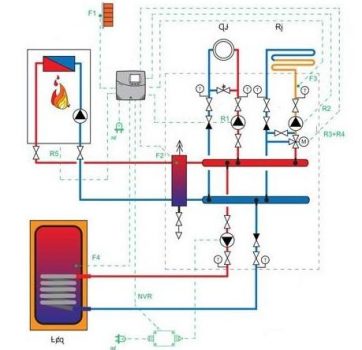
The equipment of the waterbridge avoids heat stroke, since the water pressure in each circuit will be the same. It is quite difficult to make strapping on this scheme yourself, so it is better to contact professional installers.
Option # 4 - Use of coolant recirculation
Recycling is useful when there is a circuit that needs a constant supply of hot water - for example, a heated towel rail. If it is connected to the heating system, the coolant will constantly circulate, and the dryer will function and at the same time serve as a heating device.
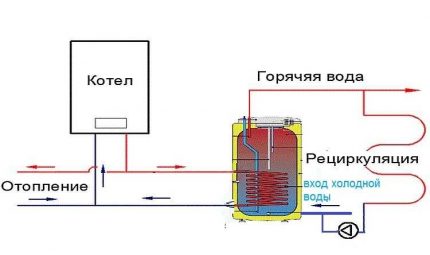
But this scheme also has drawbacks.The main one is an increase in fuel costs, because constant heating of the water cooled in the circuit is required. The second minus is the mixing of water in the boiler. Typically, hot water is in the upper part, and from there it flows to the points of drawdown, here it mixes with cold, as a result of which the temperature at the outlet is slightly lower.
There are models of boilers with built-in recirculation, that is, with ready-made pipes for connecting a heated towel rail. But it’s cheaper to buy a regular tank, using tees to connect.
Option # 5 - non-volatile boiler system
A distinctive feature of this scheme is the installation of a boiler at a higher level than the boiler and heating devices. Preference is given to wall-mounted models that can be hung at a height of 1 m above the floor.
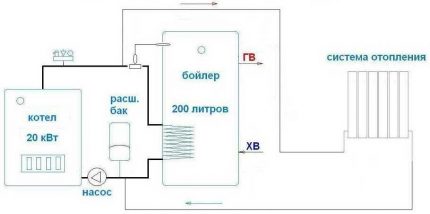
The non-volatile type of heating is based on the application of the laws of gravity, therefore, the coolant will circulate when the power is turned off. In normal operation, the circulation pumps can be connected.
Indirect heating boiler connection progress
After choosing a circuit, it becomes clear what equipment is required. In addition to the main devices, valves, ball valves, distribution combs, valves (three-way or return) may be needed.
Procedure:
- prepare the installation site (on the floor or on the wall);
- make a wiring by marking the outlets of hot / cold water in red / blue;
- integrate the tee and pressure relief valve, securing the joints with sealant;
- fasten the taps of hot (top) and cold (bottom) water;
- connection to a source of electricity, install a thermostat and automation;
- select a heating mode;
- test the connection.
These are general guidelines needed to present the scope of work. When connecting a specific model, you must follow the instructions that come with the kit.
Conclusions and useful video on the topic
The following videos will tell you how to determine the connection diagram and install the equipment correctly.
General information about wiring diagrams:
Practical tips for connecting equipment:
How to properly make the binding of an indirect heating boiler can be found in the following video:
Professional overview of a 80 liter boiler:
In addition to installing and connecting the BKN, regular maintenance is required. It consists in washing the inner cavity of the tank, removing deposits and scale, replacing the magnesium anode. Maintenance of the equipment does not require much effort. If the wiring is done correctly, an urgent repair is not required, but if you encounter problems with the equipment, we recommend that you contact a specialist.
There were questions about tying an indirect heating boiler, found inaccuracies or is there anything to advise visitors to our site? Please leave your comments below.

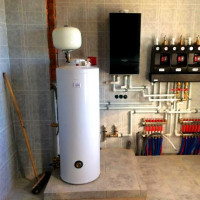 Indirect heating boiler for gas boiler: specifics of operation and connection
Indirect heating boiler for gas boiler: specifics of operation and connection 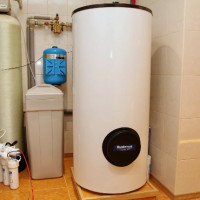 Indirect heating boiler: device, principle of operation and wiring diagrams
Indirect heating boiler: device, principle of operation and wiring diagrams 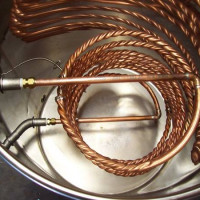 How to make a do-it-yourself indirect heating boiler: instructions and manufacturing tips
How to make a do-it-yourself indirect heating boiler: instructions and manufacturing tips 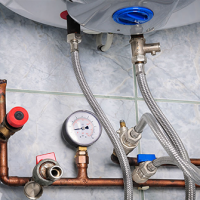 Schemes for connecting a water heater to a water supply system: how not to make mistakes when installing a boiler
Schemes for connecting a water heater to a water supply system: how not to make mistakes when installing a boiler 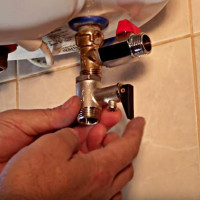 Safety valve for the boiler: design structure, operating principle and installation rules
Safety valve for the boiler: design structure, operating principle and installation rules 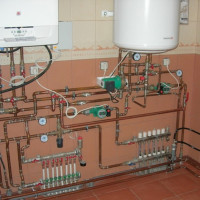 Connecting an electric boiler to a gas boiler: the best schemes and work procedures
Connecting an electric boiler to a gas boiler: the best schemes and work procedures  How much does it cost to connect gas to a private house: the price of organizing gas supply
How much does it cost to connect gas to a private house: the price of organizing gas supply  The best washing machines with dryer: model rating and customer tips
The best washing machines with dryer: model rating and customer tips  What is the color temperature of light and the nuances of choosing the temperature of the lamps to suit your needs
What is the color temperature of light and the nuances of choosing the temperature of the lamps to suit your needs  Replacement of a geyser in an apartment: replacement paperwork + basic norms and requirements
Replacement of a geyser in an apartment: replacement paperwork + basic norms and requirements
I installed a powerful 200 liter boiler at home. The master said that this boiler should be enough for bathing two people one after another.I agreed, but my joy was short-lived: my mother, who came to visit me, went to swim, she did not have enough water. The water was cold, did not have time to heat up.
The heating element was agreed with the installation wizard, but my disappointment still remains. I checked, you can use it, but you need to shut off the water all the time, and my mother is an old-school man, she needs water to flow continuously. What should I do with this 200 liter boiler and what is the way out of my situation?
Hello. To be honest, I'm confused. We have a 100 liter boiler and it’s enough to pour a full hot bath 2 times (this is with dilution). What is your boiler and what temperature mode is set on it? And how big is the bath?
Hello. Can a double-circuit boiler circuit be connected to an indirect heating boiler coil? (pressure rises as temperature rises)
Hello. It is theoretically possible through the first circuit. The piping will go through the distribution manifold. Be sure to connect the pump and the remote thermostat. The scheme is complex and inappropriate. It is better to purchase a single-circuit boiler with the ability to connect a boiler to it.
Tell me, but option 3 and option 4 can not be combined into one option? Or, in your opinion, the recirculation harness is something supernatural and so separate that it is already highlighted as a separate item.
And option 1 and 2 fit perfectly with option 4. Together and simultaneously.
Good afternoon. Tell me which scheme to choose correctly. In the boiler, the coolant is not understood more than 40 degrees. Single-circuit gas boiler SIME RMG70, Kospel boiler for 400 liters, the main heating is underfloor heating. 7 circuits 1-boiler, 1-TP to the basement, 2-TP the first floor and 2-TP the second floor. House on 350 sq.m.
Mahmoud, how will he warm you if 40 degrees coolant?
There were many options with the choice of a storage water heater, all not very successful. We bought a boiler Atlantic 100 liters, we are 3 people. Boiler installation spent quickly, enough volume with our heads, we are satisfied.